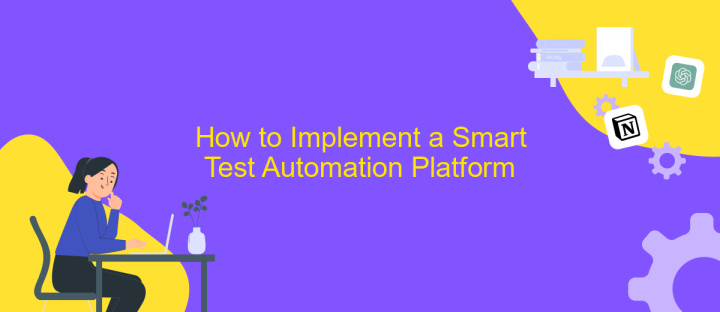Smart Test Automation Platform
In the rapidly evolving world of software development, the demand for efficient and reliable testing solutions has never been greater. Enter the Smart Test Automation Platform, a cutting-edge tool designed to streamline testing processes and enhance software quality. By leveraging advanced algorithms and intuitive interfaces, this platform empowers developers to automate complex test scenarios, reduce human error, and accelerate release cycles, ultimately driving innovation and success.
Benefits of Smart Test Automation
Smart Test Automation revolutionizes the way software testing is conducted by leveraging advanced technologies to enhance efficiency and accuracy. This approach integrates intelligent algorithms and machine learning to automate repetitive tasks, reduce human error, and accelerate the testing process. As a result, teams can focus on more complex scenarios, ensuring higher quality software releases.
- Increased Test Coverage: Smart automation tools can execute a vast number of test cases, covering more scenarios than manual testing.
- Cost Efficiency: By minimizing manual efforts, organizations can significantly reduce operational costs associated with testing.
- Faster Time to Market: Automated processes speed up testing cycles, allowing quicker product releases.
- Improved Accuracy: Automation reduces the risk of human error, leading to more reliable test results.
- Scalability: Easily scale testing efforts to accommodate growing software complexity and requirements.
By adopting a smart test automation platform, companies not only enhance their testing capabilities but also gain a competitive edge in the market. This technology empowers teams to deliver high-quality software products more efficiently, meeting the ever-increasing demands of modern software development cycles. Ultimately, smart test automation is a strategic investment that drives innovation and operational excellence.
Key Features of a Smart Test Automation Platform

Smart Test Automation Platforms are designed to enhance the efficiency and accuracy of software testing processes. One of the key features is the ability to seamlessly integrate with a wide range of development and testing tools, ensuring a streamlined workflow. This integration capability allows teams to connect with various services, such as ApiX-Drive, which simplifies the process of setting up automated workflows between different applications, enhancing productivity and reducing manual intervention. Additionally, these platforms support a variety of testing types, including functional, regression, and performance testing, ensuring comprehensive coverage and reliability.
Another significant feature is the use of artificial intelligence and machine learning to optimize test execution. These technologies enable the platform to intelligently prioritize test cases, identify potential defects early, and adapt to changes in the software environment. This not only accelerates the testing cycle but also improves the overall quality of the software product. Furthermore, smart test automation platforms often provide detailed analytics and reporting features, offering insights into test performance and helping teams make informed decisions. With these advanced capabilities, organizations can achieve faster release cycles and maintain high standards of software quality.
How to Implement a Smart Test Automation Platform

Implementing a smart test automation platform requires a strategic approach to ensure efficiency and scalability. Begin by assessing your current testing processes and identifying areas that can benefit from automation. Define clear objectives for what you aim to achieve with the platform, such as reducing test cycle time or increasing test coverage. This will guide your selection of the right tools and technologies.
- Evaluate and choose a test automation tool that aligns with your project requirements and team expertise.
- Integrate the chosen tool with your existing development and continuous integration/continuous deployment (CI/CD) pipelines.
- Develop a comprehensive test strategy that includes test case design, execution, and maintenance.
- Implement robust reporting and analytics to track performance and identify areas for improvement.
- Continuously train and upskill your team to keep pace with evolving technologies and methodologies.
Once implemented, regularly review and refine your test automation processes to adapt to changes in technology and project needs. Encourage collaboration between development and QA teams to ensure alignment and maximize the benefits of the platform. By fostering a culture of continuous improvement, your organization can achieve greater efficiency and quality in software delivery.
Challenges and Best Practices for Smart Test Automation

Implementing a smart test automation platform presents numerous challenges, such as integrating with diverse systems and maintaining test stability amidst frequent software updates. These platforms must adapt to various testing environments, requiring robust architecture and flexibility. Additionally, ensuring data security and compliance with industry standards is crucial.
Despite these challenges, smart test automation can be optimized through strategic planning and execution. Establishing clear objectives and aligning them with business goals ensures that the automation efforts deliver tangible value. Moreover, selecting the right tools and technologies tailored to specific project needs enhances efficiency and effectiveness.
- Continuously update and refine test scripts to address changes in the application.
- Leverage AI and machine learning to improve test accuracy and reduce maintenance efforts.
- Foster collaboration between development and QA teams to streamline processes.
Adopting best practices in smart test automation not only mitigates risks but also maximizes the return on investment. By focusing on adaptability, continuous improvement, and team collaboration, organizations can overcome challenges and harness the full potential of automation to deliver high-quality software faster.


Future Trends in Smart Test Automation
As the field of smart test automation continues to evolve, several trends are shaping its future. One key trend is the increasing integration of artificial intelligence and machine learning into testing frameworks. These technologies enable more adaptive and predictive testing processes, allowing for the identification of potential issues before they become critical. Moreover, AI-driven analytics can provide deeper insights into test results, enhancing decision-making and optimizing resource allocation.
Another significant trend is the growing importance of seamless integration between various tools and platforms. Services like ApiX-Drive are becoming crucial as they facilitate the effortless connection of different applications, ensuring smooth data flow and enhancing automation capabilities. This trend underscores the move towards more interconnected ecosystems where continuous integration and deployment pipelines can operate with greater efficiency. Additionally, the emphasis on cloud-based testing solutions is on the rise, offering scalability and flexibility to accommodate diverse testing needs. As organizations strive for faster delivery cycles, these trends are set to redefine the landscape of smart test automation.
FAQ
What is a Smart Test Automation Platform?
How does a Smart Test Automation Platform improve testing efficiency?
Can a Smart Test Automation Platform integrate with other tools?
What are the key features of a Smart Test Automation Platform?
Is it necessary to have programming skills to use a Smart Test Automation Platform?
Apix-Drive is a universal tool that will quickly streamline any workflow, freeing you from routine and possible financial losses. Try ApiX-Drive in action and see how useful it is for you personally. In the meantime, when you are setting up connections between systems, think about where you are investing your free time, because now you will have much more of it.

